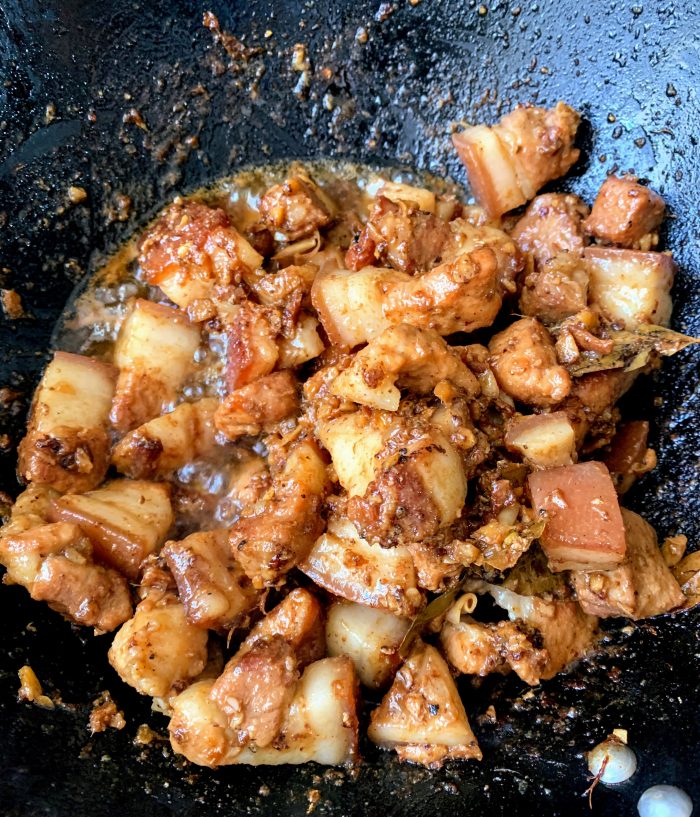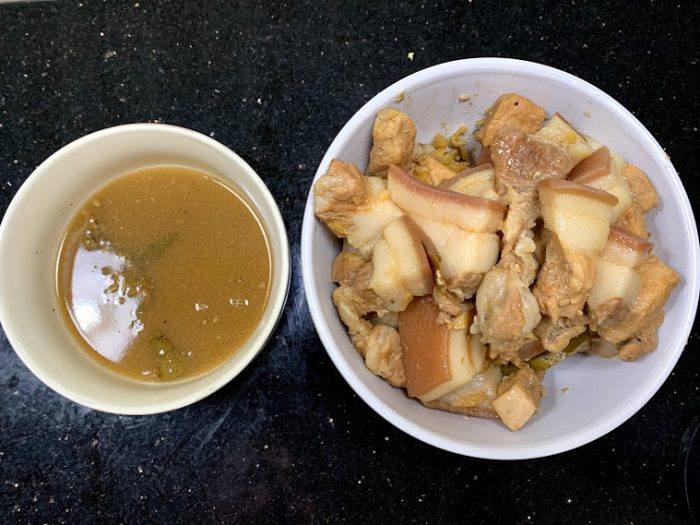
Months before “flatten the curve” entered everyone’s lexicon was this worknight when I joined two of my friends for beer after working late. When my order of fried chicken came sans the sides, I unpacked my baon, still piping hot from the office microwave two blocks away, seven floors up. (I had asked the waitress if I could sneak in my baon, as I was – and I half-winced when I confessed this to her – lessening my rice intake. Quite odd to disclose this on a blog that celebrates extra helpings of it…) Talk swerved to food, perhaps insinuated by my baon, chopsuey and, yes, boiled garbanzos. My friends confided a persistent problem most twenty-something city dwellers have: They only have a tiny kitchen with a portable single gas burner and a mini fridge. What can you cook with that space?
With limited arsenal, I immediately thought of one dish: adobo. However, the mere mention of it always merits the follow-up question: “How do you cook your adobo?”
“There are as many adobo recipes as there are Filipino cooks.” Angela Dimayuga
Food historians could only agree on adobo’s definition: it is a protein, usually pork or chicken, that’s simmered or cooked in vinegar, garlic, salt and pepper. A lot of us Filipinos hastily explain to foreigners that adobo is brought about by Spanish colonization, but a lot of studies, notably on Philippine traditional vinegars* point out that these ingredients have been present in the Philippines way before Magellan reached our islands – the journalist and food historian Raymond Solokov called this process “lexical imperialism”. Upon naming the dish that our ancestors have been making for centuries with a Spanish name (which is their word for sauce), the Spaniards ended up rewriting our culinary history. (A great read: There’s nothing Spanish about adobo – should we ditch its Spanish name?)
Another mind-blowing discovery: Soy sauce is a Chinese contribution – so it’s not as essential as the other five ingredients. This fact took years to sink in – I grew up in a household who knows adobo with soy sauce! I recently found a recipe of adobong puti (white adobo) from Marketman, which is close to the way our ancestors used to do it: using our traditional (coconut, nipa, sugar-cane) vinegar as a preservative when refrigeration was nonexistent. It is a revelation: its color (or the lack of it) betrays its complexity. Without the assertive flavor of soy sauce, the saltiness is more nuanced. It’s an exercise on restraint, and I would highly recommend anyone who couldn’t imagine an adobo without soy sauce to cook it and see for yourself.
In her chicken adobo recipe at the New York Times, Angela Dimayuga writes that “there are as many adobo recipes as there are Filipino cooks.” From late-night inuman to watercooler conversations, broaching the topic of how you cook it can be an invitation for people to recount an endless stream of takes and versions. It all boils down to this: There clearly isn’t one single recipe for adobo. Some simmer it in coconut milk for a silkier sauce; some consider sugar, oyster sauce or Sprite as essentials for that hint of sweetness; some refuse to crack or grind their black peppercorns; some add ginger (which I do for my chicken adobo) or onions, annatto or green chilies; some pre-cook their proteins; some put pork or chicken liver; some swear by a certain kind of traditional Filipino vinegar, and that when they do, they wouldn’t stir the dish for at least 15 minutes to make the dish great*; some would rather revert to old-fashioned clay pots for cooking it.
In an essay on the indigenization of food, the Filipino food critic Doreen Fernandez aptly quotes an anthropologist talking about eating as a way of “ingesting the environment”.** Adobo and its multiple versions is a testament to that, as it uses each region’s staple ingredients and imbibes each household’s preferences and palates.
With just five ingredients (six, if you like it with soy sauce) it’s also worth noting how versatile it is. It doesn’t require a lot of skill to cook it. You can simplify the recipe for a weeknight, adding all the ingredients in a pot for 40 minutes, tops. For faster cooking and easier portioning (for the next day’s baon), look no further than the humble carinderia, where they slice the pork into much smaller pieces.
You can also make it much more decadent, fit for a fiesta. This version can be filed under this category – it goes the extra mile, adding about twenty more minutes of cooking time, an additional bowl (or two) to clean, and a second batch of minced garlic. My sister – the cook in the family – cooks it this way, and everyone in our family loves pork adobo this way, and no other way. An officemate from Rizal said that in their town, they call it tuyong adobo, or dry adobo.
This adobo is drier and greasier, since the recipe calls for frying the pork in oil, giving it a bit more chew and texture in the process. It also has the slider leaning towards salty than sour. It’s an adobo that is saucy than soupy, with a thicker sarsá of browned nubs of garlic, soy and pepper.

So what you will do, after you’re done cooking your pork adobo, is to set aside the stock in one bowl, and the pork in another. Once you cleared the pan or wok where you cooked the adobo, heat about 1 tbsp of oil, and then shallow-fry your pork. Make sure you cover your wok to avoid oil splatters. You’ll want to hear the fat pop and burst in around 3 minutes. Toss it around every 3 minutes, until you get the edges of your pork seared and browned.
Then you mince a head (or half) of garlic, then mix it with the shallow-fried pork. Don’t burn the garlic like I did in the photo below – you want to just toss it with the pork for no more than 30 seconds. Added towards the end, this second layer of garlic adds a lot of fragrance and bite to this adobo.
Then you pour back the stock. Reduce it for five minutes, all the while scratching the bottom of your wok to scrape off the minced garlic.

You’ll know when it’s reduced when the sauce slightly coats your spoon, the consistency a lot like sarsá. Turn off the heat. Don’t serve it just yet: reserve some of the sarsá for tomorrow’s adobo fried rice. I would even go as far as using the very wok where I made my adobo to make fried rice the next morning…
Notes:
*Traditional Philippine Vinegars and their Role in Shaping the Culinary Culture, Pia Lim-Castillo: “In cooking Philippine dishes where vinegar is used such as in adobo, paksiw, sangkutsa, from the moment the vinegar is added to the dish, it cannot be stirred until the mixture has boiled for at least 15 minutes otherwise you end up with a raw-tasting sourness and there will be no way to fix it. Interviewing all the native cooks for the reasons behind such a practice is difficult because they cannot explain the raw flavor. The only reason I can think of is that allowing the vinegar to boil releases the esters and gives the dish a less sour finish.”
**From Culture Ingested: Notes on the Indigenization of Food, Doreen Fernandez wrote about its origin: “Adobo is the noun derived from adobado, the name of a stewed meat dish in Mexico, from where Carmen Guerrero-Nakpil says our adobo comes. In Spain, however, adobo is the pickling sauce, made by cooking together olive oil, vinegar, garlic, thyme, laurel, oregano, paprika, and salt. The Filipino has given the name adobo to his particular dish of chicken or pork-and-chicken, and derived from it an adjective to describe other foods using the same or a similar cooking process (adobong pusit.). The tern adobado has moved from the dish to the process of stewing in a spiced or flavored broth (e.g. “Ang itik sa Angono’y adobado na bago prituhin” thus using the basic meaning-to cook in a pickling sauce. And indeed the Philippine adobo is adobado – but in vinegar and garlic, laurel and peppercorns,
and occasionally soy sauce (a Chinese contribution).”
2 Comments
Sakto ah, magluluto ako ng adobo tonight. Haha. Try ko yang adobong puti.
Nice to find your little world on the Internet again. Keep writing!